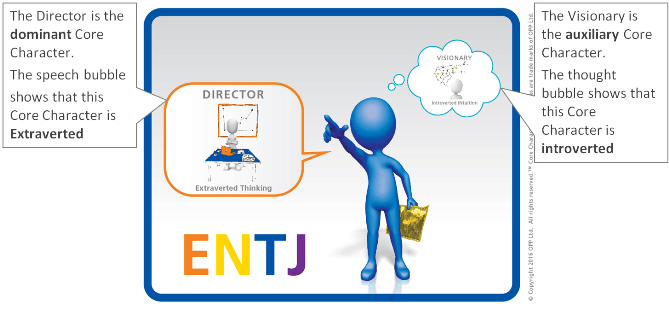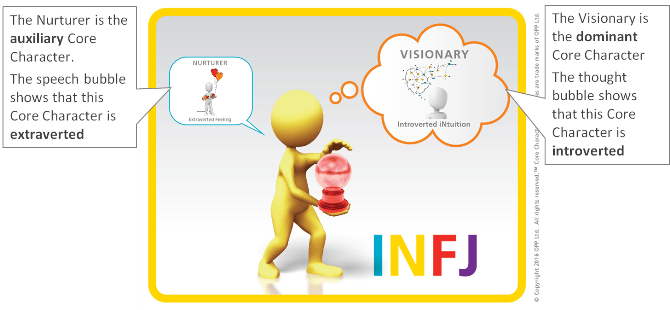Recovering from stress: Getting back to your best
Penny Moyle, CEO at OPP and John Hackston, Head of Research at OPP
If you have been following our recent blogs, by now you’ll be familiar with OPP’s Core Characters of Type. Core Characters are an engaging way to illustrate both the most preferred part of our MBTI personality Type (in technical Type jargon, each Type’s dominant function) and our other functions (auxiliary, tertiary and forth, or inferior). In April, to mark Stress Awareness Month, we focused on what happens to our leading Core Character both under everyday stress and in the face of more severe pressure.
We have observed that under everyday stress, we tend to rely more and more on the most trusted part of our personality, our leading Core Character, which leads it to become exaggerated. When out of proportion in this way, we can become like a caricature of our normal, mature, well-rounded selves – over-reliant on doing things in just one way, and losing the usual balance of our auxiliary function (our secondary Core Character).
The Inside-Outside Typies can be a helpful way to look in more detail at what happens in terms of balance when we become stressed. Below are examples of these Typies for an extraverted Type (ENTJ) and an introverted Type (INFJ).


- At our best, we have one extraverted Core Character (in the speech bubble) and one introverted Core Character (in the thought bubble) working together
- One of these two is our favourite (the extraverted character for Extraverts; the introverted character for Introverts)
- Under everyday stress, we tend to over-rely on our favourite Core Character, meaning that it becomes exaggerated, and the secondary Core Character essentially disappears
- When this happens, we find that Extraverts get very loud, and Introverts become withdrawn
- The other way in which we lose balance is that for each Type, one of these two Core Characters is about taking in information (either Sensing or iNtuition) and the other is about making decisions (either Thinking for Feeling). So when we try to make do with just one of the pair, we either over-rely on taking in information (without making decisions) or we try to make decisions too quickly (without sufficient information) – resulting either in a complete lack of progress, or progress in the wrong direction!
To keep in good balance, we should always remind ourselves to have a balance of extraverted and introverted time, and to ensure that we attend both to taking in information as well as making decisions. Learning to recognise when your favourite (dominant) Core Character is taking over, is a great way to keep yourself in check. The simple rules of thumb are:


If you are successful in keeping in balance, your favourite Core Character won’t become overworked and exaggerated. Even under severe pressure, you might manage to prevent yourself from falling into the grip experience where we have exhausted our dominant function and our psyche flips over into the opposite Core Character – our inferior function. However, if you do find yourself in that dark place, these same rules of thumb can be helpful. Accessing your secondary Core Character is the key through which you can restore balance.
Hints and tips for anyone under severe pressure:
- Breathe: if you practice yoga, mindfulness or Pilates then this is likely to help too, but if not, just a few deep breaths at regular intervals is a great start
- Take a break; try something different
- Look after yourself: exercise, eat well, sleep
- Reflect on what you know about your personality, and consider how you might restore the balance between taking in information and making decisions so that you can get on with making good decisions and move things forward
- Introverts – don’t be afraid to discuss what’s going on with a trusted other
- Extraverts – don’t be afraid to step back from action and discussion in order to think through your next steps
If you want to know more about Core Characters, check out our recent blogs and downloads.
- Introducing the Core Characters of Type
- Inside-Outside Typies: decoding communication issues between different MBTI Types
- Everyday stress: using Core Characters to understand what happens
- Quick Guide to Everyday Stress
- Core Characters under great stress: the grip experience
We’ve updated our earlier downloads about Core Characters under everyday stress and in the grip to incorporate Type-specific tips for regaining balance. You can download the updated presentation slides and other free practitioner slide decks from the Practitioner Resources area of the OPP website. You’ll find the whole series of the four Core Character presentations by searching ‘Core Characters’. This content is only available to MBTI practitioners registered with OPP.
You might also want to listen to our recent free webcast about everyday stress.
If you’ve enjoyed the blog or the Core Characters and stress download series then please tell us your thoughts by using the comments box below. If there are other application areas you think we should write about then let us know.